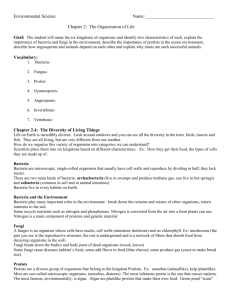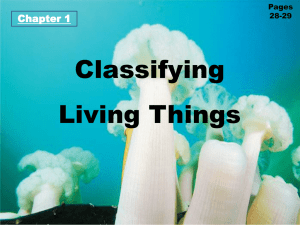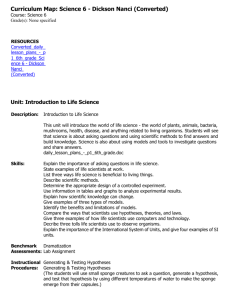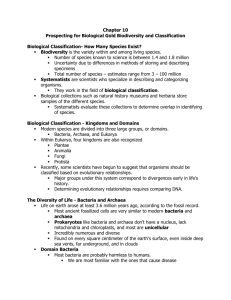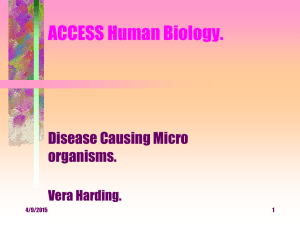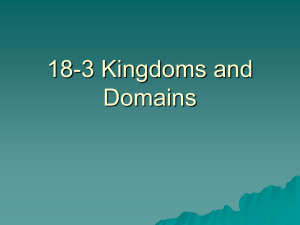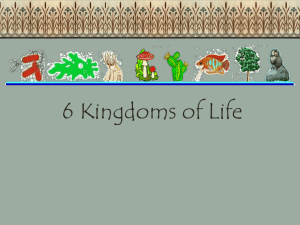Plants
advertisement
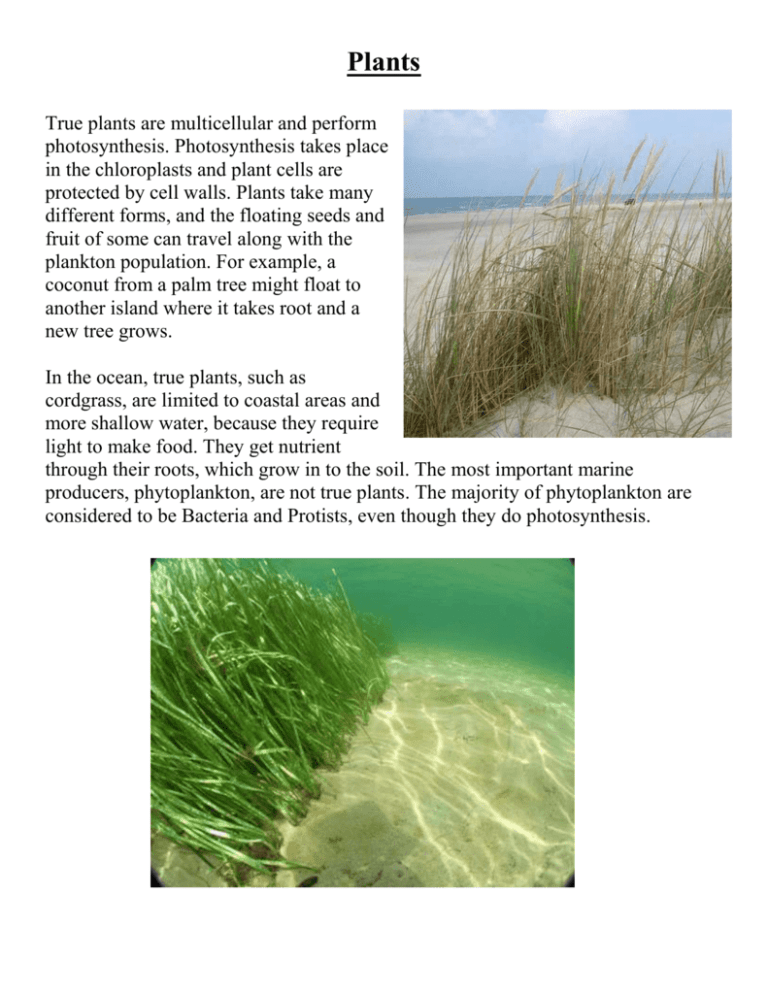
Plants True plants are multicellular and perform photosynthesis. Photosynthesis takes place in the chloroplasts and plant cells are protected by cell walls. Plants take many different forms, and the floating seeds and fruit of some can travel along with the plankton population. For example, a coconut from a palm tree might float to another island where it takes root and a new tree grows. In the ocean, true plants, such as cordgrass, are limited to coastal areas and more shallow water, because they require light to make food. They get nutrient through their roots, which grow in to the soil. The most important marine producers, phytoplankton, are not true plants. The majority of phytoplankton are considered to be Bacteria and Protists, even though they do photosynthesis. Animals When we think of ocean animals, we often think of animals like those we can track: whales, dolphins, sea turtles, fish, etc. However, some of the most important animals in the ocean are tiny members of the plankton community. The large majority of animals on Earth are unlike humans and other mammals. These animals include jellyfish, sea stars, clams, squid, and many more. These animals are called invertebrates and none of these animals have a backbone. Most marine invertebrates spend at least a part of their lifetime within the plankton community. Many marine invertebrates do not move very fast, if at all. To ensure the survival of their species, invertebrates must find a way to reproduce, even if they never meet another of their kind. Corals are one type of invertebrate animal that does not move. Their reproduction strategy is to release eggs and sperm directly into the water. When these two cells meet, the egg is fertilized, and the cell begins to divide. The baby, or larval stage, floats within the plankton community until it gets too big and settles on the ocean bottom. This is a way for organisms that move slowly, or not at all, to colonize new habitats. Other organisms that you might not think of as animals, but are, follow the same strategy. These include sponges, clams, and anemones. Animals have true organelles, including a nucleus. They feed on other organisms. Fungi You are probably familiar with mushrooms and mold. These are both examples of fungi. Fungi latch onto other organisms and eat them by absorbing the food through their cell wall. For example, you have probably seen a mushroom growing on a tree. This fungus is taking nutrition away from the tree through its cell wall and membrane. Fungi have true organelles, making them eukaryotic. Fungi on land and in estuaries are important decomposers. They break down waste and dead organisms, releasing nutrients back into the ecosystem. In the ocean, fungi can be very harmful. Some types of marine fungi make fish very sick by invading their tissues. These fungi can remain in the plankton population until they latch onto a victim. Most marine fungi can only be seen with a microscope. Protists Protists are very strange organisms and a very diverse group. Some protists photosynthesize; others are heterotrophic. Some can cause diseases, such as malaria. Most protists have cell walls, some have chloroplasts, and all have a nucleus and cell membrane. Diatoms and dinoflagellates are important marine producers. These protists are unicellular. Other protists are multicellular. Interestingly, most seaweeds, such as kelp and rockweed, are not plants at all; they are multicellular protists. Bacteria Bacteria are also known as true bacteria. These microorganisms are the most abundant organisms in the ocean. Cyanobacteria are a type of photosynthetic bacteria that are thought to maybe be the first producers on Earth. Not all bacteria are producers, however. True bacteria live in most Earth habitats, including inside our bodies. For example, there are bacteria that live inside our intestines that help us to produce vitamins. These bacteria are heterotrophs that get their nutrition from your body, but your cells use the vitamins created to help complete the body’s processes. Many of the true bacteria are decomposers. They break down dead organisms and waste and return their nutrients to the Earth system. Some of the true bacteria are not as helpful. Some cause diseases that infect humans and other organisms. For example, some types of true bacteria cause strep throat, pneumonia, and ear infections. True bacteria are unicellular, but they reproduce quickly so there will be a lot of them, fast, if they are meeting their needs. Archaea Archaea are similar to Bacteria in that they are single-celled microbes. Their cells do not have nuclei or true organelles. They differ from the true bacteria in biochemical ways. For example, they have different enzymes and mechanisms for building proteins within their cells. When they were first identified, these organisms were also known as they “extreme bacteria” because of the extreme habitats in which they are found. Archaea live in some of the harshest environments on Earth, including hot spring, super salty lakes, and places with absolutely no oxygen. Prior to the discovery of these types of organisms, scientists assumed that nothing could live under such extreme conditions. Archaea can be autotrophs or heterotrophs. The autotrophic Archaea do not only photosynthesize, however. Insteead of using sunlight to make energy, some of these unique organisms use chemicals. The process of using chemicals to make energy is called chemosynthesis. Archaeans that live and thrive in very salty seas and lakes are called halophiles. Those that thrive on natural gas (methane) are called methanogens and are found in the deep ocean. Archaeans found in very hot conditions are called thermophiles. Most recently, scientists have learned that Archaea are found in almost every Earth environment and are especially abundant in the ocean.
